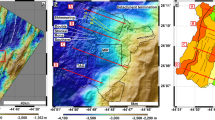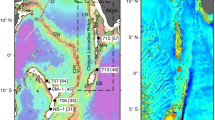Abstract
The coexistence of multifaceted geodynamical situation in the Northeastern Indian Ocean (Bay of Bengal) lithosphere inspires to investigate the origin, present day orientation and gravitational stability of its basement, crust and lithospheric structures. The origin, evolution and the present day configuration of these structures such as the northward down dipping of the Bay of Bengal basement and its lithosphere, the Moho of the 85°E ridge, the formation of the Ninetyeast ridge median graben and ridge normal faults and their interaction with slow convergence and stress diffusion processes in the north Andaman trench, remain conspicuous. In this paper, we explain the above mentioned processes and the existence of the Bay of Bengal basement features through plausible tectonic scenarios that related with past time dynamics of the Indian Plate prior to the India-Eurasia collision and lithospheric thermal perturbation due to the Ninetyeast Ridge magmatism.
Our analysis on the basis of satellite altimeter-derived geoid, gravity, sediment thickness, basement undulation, isostatic and prospecting geoid anomaly; suggests apart from the enhanced Oligocene Himalayan erosion and subsequent increased sediment load, the gravitational stability of the basin load (like formation of ridge graben) was also affected by altering the basin rheology to inelastic, owing to the enhanced thermal perturbation by the ninetyeast ridge magma. This made the Bay of Bengal lithosphere rheologically weak. Pre India-Eurasia collision, fast movement and fast convergence of the Indian plate at erstwhile north Andaman subduction zone made the lithosphere relatively stretchable due to the prevalence of intra-plate extensional stresses. The NE-SW orientation of the Central basin depression and the northward (NE-SW) dipping of the Bay of Bengal (BOB) lithosphere are pointing to such a stretchable lithosphere and its remnants are present at the northeast of the northern Ninetyeast ridge, as observed from the low prospecting geoid anomaly. The presence of such a thermally altered, weak lithosphere as a subducting slab at the north Andaman trench caused the present day observed low convergence rate, lack of seismicity, as well as the cessation of fault rupture followed by the Great Sumatra Andaman earthquake of Mw (9.1) on 26 December 2004. The Ninetyeast ridge oblique collision with the north Andaman trench was presumed around Pleistocene based on the timing of abandonment of the Nicobar fan from the Bengal head fan. The discontinuity of the ridge along the oblique convergence zone of the north Andaman and its isostatic stability are mainly controlled by the subduction zone dynamics, unlike the 85°E ridge.
Similar content being viewed by others
References
AIRY, G.B. (1855) On the computation of the effect of attraction of mountain-masses, as disturbing the apparent astronomical latitude of stations of geodetic surveys. Phil.l Trans. Royal Soc., v.145, pp.101–104.
Curray, J.R., Emmel, F.J., Moore, D.G. and Raitt, M.W. (1982) Structure, tectonics and geological history of the northeastern Indian Ocean. In: A.E.M., Nairn, F.G., Stehli, and S., Uyeda (Eds.), The Ocean Basins and Margins, 6 The Indian Ocean Plenum, New York, pp.399–449.
Curray, J.R. (1994) Sediment volume and mass beneath the Bay of Bengal. Earth Planet. Sci. Lett., v.125, pp.371–383.
ETOPO2 (Earth Topography): Relief Map Of The Earth’S Surface (1986) EOS Transactions of the American Geophysical Union 67, 121 p., downloaded from: http://edcsgs9.cr.usgs.gov/glis/hyper/guide/etopo5.
France-Lanord, C., Speiss, V., Molnar, P. and Curray, J.R. (2000) Summary on the Bengal Fan. source: http://www.whoi.edu/ pclift/BengalSummary.pdf.
Gahalaut, V.K., Subrahmanyam, C., Kundu, B, Catherine, J.K. and Ambikapathy, A. (2010) Slow rupture in Andaman during 2004 Sumatra-Andaman earthquake: a probable consequence of subduction of 90°E ridge, Geophys. Jour. Internat., v.180, pp.1181–1186.
Gopala Rao, D., Bhattacharya, G.C., Ramana, M.V., Subrahmanyam, V., Ramprasad, T., Krishna, K.S., Chaubey, A.K., Murty, G.P.S., Srinivas, K., Anddesa, M. (1994) Analysis of multi-channel seismic reflection and magnetic data along 13° N latitude across the Bay of Bengal. Marine Geophys. Res., v.16, pp.225–236.
Gopala Rao, D., Krishna, K.S. and Sar, D. (1997) Crustal evolution and sedimentation history of the Bay of Bengal since the cretaceous. Jour. Geophys. Res., v.102, pp.17,747–17,768.
Haxby, W.F. and Turcotte, D.L. (1978) On isostatic geoid anomalies. Jour. Geophys. Res., v.83, pp.5473–5478.
Ingle, S., Weis, D., Scoates, J.S. and Frey, F.A. (2002) Relationship between the early Kerguelen Plume and continental flood basalts of the paleo-Eastern Gondwana margins. Earth & Planet. Sci. Letts., v.197, pp.35–50.
James, Nt. and Barazangi, M. (1984) Seismotectonics of the Himalayan collision zone: Geometry of the underthrusting Indian plate beneath the Himalaya. Jour. Geophys. Res., v.89(B2), pp.1147–1163.
Klootwijk, C.T., Gee, J.S., Pierce, J.W., Smith, F.M. and Mcfaddan, P.L. (1992) An early India-Asia contact: Palaeomagnetic constraint from Ninety-east ridge. ODG Leg 121, Geology, v.20, pp.395–398.
Krishna, K.S. (2003) Structure and evolution of the Afanasy Niktin seamount, buried hills and 85° E ridge in the northeastern Indian Ocean. Earth Planet. Sci. Lett., v.209, pp.379–394.
Ledain, A.Y., Tapponnier, P., Andmolnar, P. (1984) Active faulting and tectonics of Burma and surrounding regions. Jour. Geophys. Res., v.89, pp.452–472.
Lemoine, F.G., et al. (1998) EGM96, The NASA GSFC and NIMA Joint Geopotential Model. cddis.gsfc.nasa.gov
Liu, C.S., Sandwell, D.T. and Curray, J.R. (1982) The negative gravity field over the 85oE ridge. Jour. Geophys. Res., v.87, pp.7673–7686.
Mahoney, J.J., Macdougall, J.D., Lugmair, G.W. and Gopalan, K. (1983) Kerguelen hotspot source for Rajmahal traps and Ninetyeast ridge? Nature, v.303, pp.385–389.
Majumdar, T.J., Mohanty, K.K. and Srivastava, A.K. (1998) An atlas of satellite-derived gravity over the Indian offshore. ISRO-ONGC Joint Report No. SAC/RSAG/TR-01/98, 40p.
Müller, R.D., Roest, W.R., Royer, J.Y., Gahagan, L.M. and Sclater, J.G. (1997) Digital isochrons of the world’s ocean floor. Jour. Geophys. Res., v.102, pp.3211–3214.
Murthy, I.V.R. and Rao, D.B. (1979) Gravity anomalies of twodimensional bodies of irregular cross-section with density contrast varying with depth. Geophys., v.44, pp.1525–1530.
Parker, R.L. (1973) The rapid calculation of potential anomalies. Geophys. Jour. Royal Astron. Soc., v.31, pp.445–455.
Patriat, P. and Acache, J. (1984) India-Eurasia collision chronology has implications for crustal shortening and driving mechanism of plates. Nature, v.311, pp.615–621.
Pateria, M.L., Rangaraju, M.K. and Raiverman, V. (1992) A note on the structure and stratigraphy of Bay of Bengal sediments. Geol. Surv. India, Spec. Publ. no.29, pp.21–23.
Pratt, J.H. (1855) On the attraction of the Himalaya mountains, and of the elevated regions beyond them, upon the plumb line in India. Phil. Trans. Royal Soc., v.145, pp.53–100.
Radhakrishna, M. and Sanu, T.D. (2000) Seismotectonics and rates of active crustal deformation in the Burmese arc and adjacent regions. Jour. Geodyn., v.30, pp.401–421.
Rajesh, S. and Majumdar, T.J. (2003) Geoid generation and subsurface structure delineation under the Bay of Bengal, India using satellite altimeter data. Curr. Sci., v.84(11), pp.1428–1436.
Rajesh, S. and Majumdar, T.J. (2004) Generation of 3-D geoidal surface of the Bay of Bengal lithosphere and its tectonic implications. Internat. Jour. Rem. Sens., v.25(15), pp.2897–2902.
Rajesh, S. (2006) Studies on the Bay of Bengal oceanic lithosphere based on satellite altimeter-derived geoid and gravity data. Ph.D. Thesis, Gujarat University, Ahmedabad, 187p.
Rajesh, S. and Majumdar, T.J. (2010) Geoid height versus topography of the Northern Ninetyeast Ridge: Implications on crustal compensation. Marine Geophys. Res., DOI 10.1007/s11001-010-9088-7.
Ramana, M.V., Subrahmanyam, V., Chaubey, A.K., Ramprasad, T., Sarma, K.V.L.N.S., Krishna, K.S., Desa, M., Murty, G.P.S. and Subrahmanyam, C. (1997) Structure and origin of the 85° E ridge. Jour. Geophys. Res., v.102(B8), pp.17,995–18,012.
Satyabala, S.P. (1998) Subduction in the Indo-Burman region: is it still active? Geophys. Res. Lett., v.25, pp.3189–3192.
Sreejith, K.M., Radhakrishna, M., Krishna, K.S. and Majumdar, T.J. (2011) Development of the negative gravity anomaly of the 85?E Ridge, northeastern Indian Ocean — A process oriented modelling approach. Jour. Earth Sys. Sci., v.120(4), pp.605–615.
Srivastava, A.K., Majumdar, T.J. and Mohanty, K.K. (1997) Determination of satellite gravity from closely spaced repeat passes of ERS-1 altimeter data. ISRO-ONGC Joint Report, Vol. 1 & 2, KDMIPE (ONGC), Dehradun, India.
Talwani, M., Worzel, J. and Landisman, M. (1959) Rapid gravity computations for two dimensional bodies with application to the Mendocino submarine fracture zone. Jour. Geophys. Res., v.64, pp.49–59.
Telford, W.M., Geldart, L.P. and Sheriff, R.E. (1990) Applied Geophysics. Second Edition. Cambridge University Press, Cambridge.
Watts, A.B. (2001) Isostasy and flexure of the lithosphere. Cambridge University Press, Cambridge.
Wessel, P. and Smith, W.H.F. (2001) The Generic Mapping Tools (GMT) version 3.4, Technical Reference & Cookbook, SOEST/NOAA.
Author information
Authors and Affiliations
Corresponding author
Rights and permissions
About this article
Cite this article
Rajesh, S., Majumdar, T.J. Effects of Ninetyeast Ridge magmatism and pre India-Eurasia collision dynamics on basement and crust-lithospheric structures of the Northeastern Indian Ocean. J Geol Soc India 84, 531–543 (2014). https://doi.org/10.1007/s12594-014-0161-8
Received:
Accepted:
Published:
Issue Date:
DOI: https://doi.org/10.1007/s12594-014-0161-8




